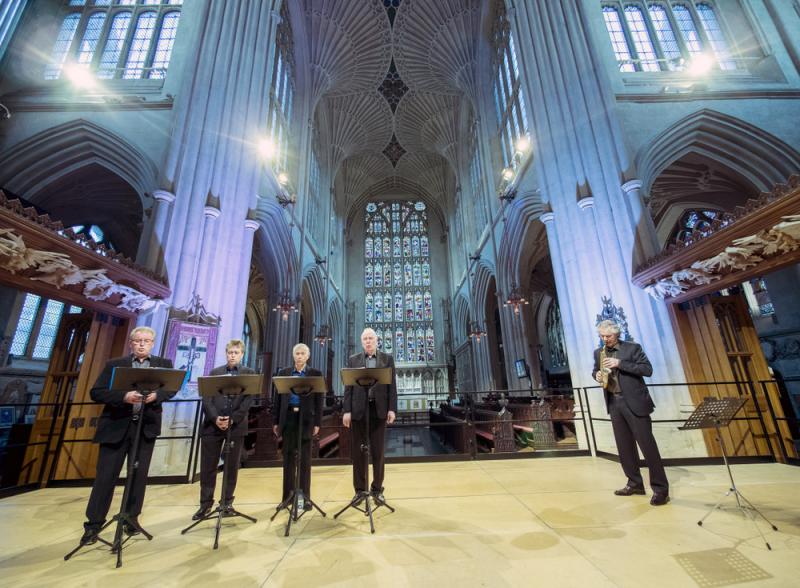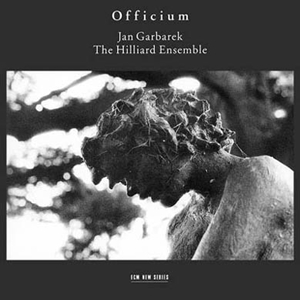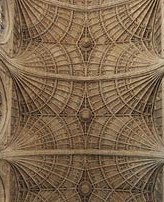Garbarek, Hilliard Ensemble, King's College Chapel Cambridge | reviews, news & interviews
Garbarek, Hilliard Ensemble, King's College Chapel Cambridge
Garbarek, Hilliard Ensemble, King's College Chapel Cambridge
The Hilliards and Garbarek know how to play the building

This was “Officium – the final concert.” The Hilliard Ensemble took their decision around three years ago to disband as a group, and – for three of them – to retire, rather than to re-launch with a new generation of voices. They are now on the road doing a series of farewells. Their final bow will be at the Wigmore Hall on December 20th, and between now and then, their victory lap takes in Taunton, Gdansk, Châlons-en-Champagne, Florence and Cologne.
I n July1994, the saxophonist and the vocal ensemble gave their first UK concert together in the same location. Back then, it had taken quite an effort to get the tickets shifted, notably the special pre-release of a track from the Officium (image of album cover right – just released on vinyl) to be played on BBC Radio 4's Kaleidoscope; last night's concert had been sold out for several months in advance.
n July1994, the saxophonist and the vocal ensemble gave their first UK concert together in the same location. Back then, it had taken quite an effort to get the tickets shifted, notably the special pre-release of a track from the Officium (image of album cover right – just released on vinyl) to be played on BBC Radio 4's Kaleidoscope; last night's concert had been sold out for several months in advance.
This valedictory concert included items from all three of those albums, performed as an uninterrupted sequence, and, as has always been the habit of this combination, with no set-list published. The Hilliards were also re-joined for most of the programme by one of their original core members, and a key instigator of their sound, the tenor (and one-time King's College Cambridge chorister) John Potter, who left the group in 1998 to be replaced by Steven Harrold.
The group and Garbarek have developed their particular ways of performing, which essentially give Garbarek the freedom to roam, to comment, to improvise around what they do. Their super-slow-mo version of Thomas Tallis' “O Lord in Thee is all my Trust” from Mnemosyne gave Garbarek the space, and one of many opportunities to wander off into the choir and send volleys of his unique soprano saxophone sound echoing round the chapel from far away. The sense of a distance between what the Hilliards do and what Garbarek does has been the constant in this collaboration. As the counter-tenor in the group David James admitted recently in an article: “Jan has never once looked at a single piece of the music we sing”.
 The Hilliards and Garbarek know how to play the building. Listeners appreciate these far-away, ethereal, celestial sounds. There are times when it is impossible to tell whether the voices are coming from in front, or from behind, and eyes are drawn towards the architectural detail of the building (detail of King's College Chapel ceiling fan-vaulting left)
The Hilliards and Garbarek know how to play the building. Listeners appreciate these far-away, ethereal, celestial sounds. There are times when it is impossible to tell whether the voices are coming from in front, or from behind, and eyes are drawn towards the architectural detail of the building (detail of King's College Chapel ceiling fan-vaulting left)
The most poignant performance of the evening was of a piece dedicated to the Hilliards. It stood out as being the only one performed without Garbarek. Arvo Pärt's “Most Holy Mother of God” was written for them in 2003, and mostly consists of the same phrase repeated mantra-like, with silence between each iterated phrase. It worked superbly, and also underlined the Estonian composer's significance in the Hilliards' back-story. The Hilliards were introduced in person to both Pärt himself and to Manfred Eicher at a recording session in East London in 1985 and that surprise encounter led to the Hilliard's first recording for ECM the following year, and provided the spark for much of what was to happen subsequently.
At the end of the evening, after a 70-minute set, the group came full circle. After their first encore, the 17th-century Scottish lament "Remember Me My Dear”, the second, and the very last piece Jan Garbarek and the Hilliard Ensemble performed, was the first which they had ever tried out together, back in 1994, “Parce Mihi Domine”, by Cristóbal de Morales (1500-1553).
After it, the musicians stepped back onto the small stage in front of the rood screen in King's College Chapel for the last time, and Manfred Eicher of ECM came on too, to take a final bow alongside them. Eicher had definitely earned his place on that stage, in front of the packed ante-chapel. It was his original idea to bring Garbarek and the Hilliards together, and the ECM aesthetic, vision, and commercial network that have been at the heart of this unlikely success.
But not even Eicher could have foreseen how prophetic the very last words of the Morales motet sung (in Latin) would be: “For now I shall lie in the earth; thou wilt seek me, but I shall not be.” Now that's spooky.
rating
Explore topics
Share this article
The future of Arts Journalism
You can stop theartsdesk.com closing!
We urgently need financing to survive. Our fundraising drive has thus far raised £49,000 but we need to reach £100,000 or we will be forced to close. Please contribute here: https://gofund.me/c3f6033d
And if you can forward this information to anyone who might assist, we’d be grateful.

Subscribe to theartsdesk.com
Thank you for continuing to read our work on theartsdesk.com. For unlimited access to every article in its entirety, including our archive of more than 15,000 pieces, we're asking for £5 per month or £40 per year. We feel it's a very good deal, and hope you do too.
To take a subscription now simply click here.
And if you're looking for that extra gift for a friend or family member, why not treat them to a theartsdesk.com gift subscription?
more Classical music
 Cho, LSO, Pappano, Barbican review - finely-focused stormy weather
Chameleonic Seong-Jin Cho is a match for the fine-tuning of the LSO’s Chief Conductor
Cho, LSO, Pappano, Barbican review - finely-focused stormy weather
Chameleonic Seong-Jin Cho is a match for the fine-tuning of the LSO’s Chief Conductor
 Classical CDs: Shrouds, silhouettes and superstition
Cello concertos, choral collections and a stunning tribute to a contemporary giant
Classical CDs: Shrouds, silhouettes and superstition
Cello concertos, choral collections and a stunning tribute to a contemporary giant
 Appl, Levickis, Wigmore Hall review - fun to the fore in cabaret and show songs
A relaxed evening of light-hearted fare, with the accordion offering unusual colours
Appl, Levickis, Wigmore Hall review - fun to the fore in cabaret and show songs
A relaxed evening of light-hearted fare, with the accordion offering unusual colours
 Lammermuir Festival 2025, Part 2 review - from the soaringly sublime to the zoologically ridiculous
Bigger than ever, and the quality remains astonishingly high
Lammermuir Festival 2025, Part 2 review - from the soaringly sublime to the zoologically ridiculous
Bigger than ever, and the quality remains astonishingly high
 BBC Proms: Ehnes, Sinfonia of London, Wilson review - aspects of love
Sensuous Ravel, and bittersweet Bernstein, on an amorous evening
BBC Proms: Ehnes, Sinfonia of London, Wilson review - aspects of love
Sensuous Ravel, and bittersweet Bernstein, on an amorous evening
 Presteigne Festival 2025 review - new music is centre stage in the Welsh Marches
Music by 30 living composers, with Eleanor Alberga topping the bill
Presteigne Festival 2025 review - new music is centre stage in the Welsh Marches
Music by 30 living composers, with Eleanor Alberga topping the bill
 Lammermuir Festival 2025 review - music with soul from the heart of East Lothian
Baroque splendour, and chamber-ensemble drama, amid history-haunted lands
Lammermuir Festival 2025 review - music with soul from the heart of East Lothian
Baroque splendour, and chamber-ensemble drama, amid history-haunted lands
 BBC Proms: Steinbacher, RPO, Petrenko / Sternath, BBCSO, Oramo review - double-bill mixed bag
Young pianist shines in Grieg but Bliss’s portentous cantata disappoints
BBC Proms: Steinbacher, RPO, Petrenko / Sternath, BBCSO, Oramo review - double-bill mixed bag
Young pianist shines in Grieg but Bliss’s portentous cantata disappoints
 theartsdesk at the Lahti Sibelius Festival - early epics by the Finnish master in context
Finnish heroes meet their Austro-German counterparts in breathtaking interpretations
theartsdesk at the Lahti Sibelius Festival - early epics by the Finnish master in context
Finnish heroes meet their Austro-German counterparts in breathtaking interpretations
 Classical CDs: Sleigh rides, pancakes and cigars
Two big boxes, plus new music for brass and a pair of clarinet concertos
Classical CDs: Sleigh rides, pancakes and cigars
Two big boxes, plus new music for brass and a pair of clarinet concertos
 Waley-Cohen, Manchester Camerata, Pether, Whitworth Art Gallery, Manchester review - premiere of no ordinary violin concerto
Images of maternal care inspired by Hepworth and played in a gallery setting
Waley-Cohen, Manchester Camerata, Pether, Whitworth Art Gallery, Manchester review - premiere of no ordinary violin concerto
Images of maternal care inspired by Hepworth and played in a gallery setting
 BBC Proms: Barruk, Norwegian Chamber Orchestra, Kuusisto review - vague incantations, precise laments
First-half mix of Sámi songs and string things falters, but Shostakovich scours the soul
BBC Proms: Barruk, Norwegian Chamber Orchestra, Kuusisto review - vague incantations, precise laments
First-half mix of Sámi songs and string things falters, but Shostakovich scours the soul

Add comment